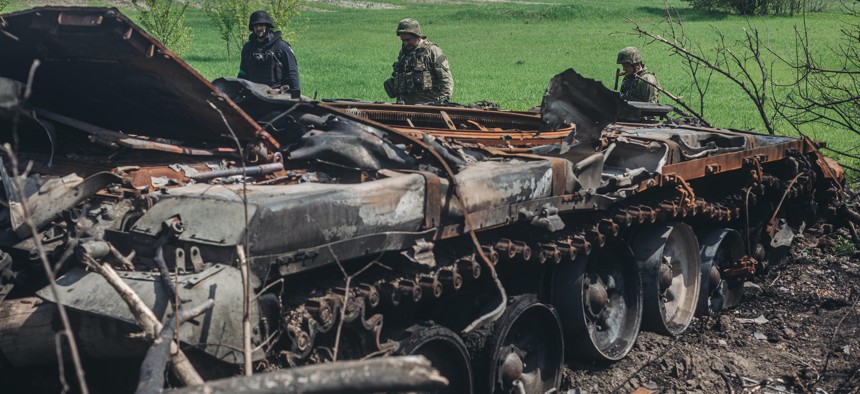
Ukrainian soldiers next to a destroyed Russian tank on the outskirts of Kharkiv, Ukraine, May 8, 2022. Anadolu Agency via Getty Images / Diego Herrera Carcedo
Training, Logistics Snafus Show How US Advisors Could Help Ukraine, Volunteers Say
Time, effort, and materiel are being wasted for lack of a little expertise, say two U.S. volunteers recently returned from the war-torn country.
Endless images of damaged Russian tanks show how Ukrainians are putting U.S. Javelin missiles to use—and yet they could be fighting even more effectively if more U.S. advisors were there to help, say two U.S. volunteers who recently returned from the war-torn country.
Mark Hayward, a retired U.S. Special Forces operator from Alaska, went to Ukraine shortly after the war broke out and soon found himself training Ukrainians to use the shoulder-fired Javelin anti-tank missile. He said that the United States is missing a key opportunity by not sending more military advisors to offer training on weapons and help with logistics.
“We should have had American advisors in country with these units,” he told Defense One. When asked if the lack of such trainers was hurting Ukrainian efforts to retake key areas from Russian forces, he said, “Yes. I say that that's fair.”
Official U.S. announcements about the delivery of weapons to Ukraine conceal a far more complex reality. Hayward recounted how some Javelin launchers arrived on the front lines without key parts or instructions. The launchers’ lithium-ion batteries often held enough charge for only a few shots, which made training on the systems difficult. Using old motorcycle batteries, he developed a “craptastic” battery pack. “We just spliced together cables with alligator clips and little pieces of wire. We actually salvaged the connectors by breaking open the wiring harness for an old CPU fan.”
Hayward said Ukrainian troops were even more resourceful. They figured out how to use 3-D printers in the field to manufacture key components, such as the six-pin plug that connects the battery. “They actually made a working prototype,” he said. “We put this homemade thing into a $100,000 command launch unit and we powered it. And thank god it worked.” They also created a manual in Ukrainian that went viral, he said. But all this improvisation drains time for other tasks.
Some of the components went missing because they arrived in different boxes, or because the Ukrainians didn’t know to request them, according to a second U.S. volunteer.
“You get Javelin rockets in the warehouse and each rocket is supposed to come with" a battery, said the second volunteer, who asked to remain anonymous. “We got a bunch of rockets. We didn't get any batteries because nobody knew...they're in different boxes. That battery comes in a cardboard box and the rocket comes in a big plastic protective case. They grabbed the case. Nobody even knew what was supposed to be with it.”
But it’s not just the batteries. According to the Javelin manual, units are supposed to ship with a field tactical training unit—basically, a small device that attaches to the launcher to help practice tracking targets and firing its missile.
“These would be a rather useful tool to send out to these frontline units,” said Hayward. But the U.S. government was late in sending them, he said “because the Ukrainians didn't ask for them.”
As a result, a lot of Ukrainians fired a Javelin for the first time in combat. “There's no hands-on practice. The first time they do any of that is with a live missile under a four-minute countdown clock from the [battery coolant unit] while they're facing live Russian attack,” he said.
Don't miss:
While Hayward said that the Defense Department has since promised to send more training devices, his experience suggests that those vital components could well wind up in a box somewhere far from the front lines. What’s really needed, he said, are official U.S. advisors to offer training and help with logistics.
“We have to have advisors embedded with us. We have to have mobile training teams, because if we don't do that we will not only miss problems like this one, but we will miss problems that will come up later simply because our eyes and ears are far from the battlefield.”
The United States was training Ukrainian forces in the western part of the country until just before the start of the war. Since the onset of hostilities, this training has moved to Germany.
But much of the pre-war training was geared toward the relatively low-level battles that Ukrainian forces had been waging against Russian-supported separatists since 2014, not the more intense warfare that has taken place this year, said one retired senior U.S. military officer who spent years training Ukrainians.
“We focused on the type of fighting that was occurring in the Donbas and the type of fighting that was occurring there was really almost static, trench-type warfare with a lot of indirect fire,” he said. “I guess in hindsight, you know, especially from what we're hearing from our intel community, basically they [meaning the U.S. intelligence community] saw this attack coming for quite some time.” Despite that advance warning, he says, “We were kind of late to the dance there in order to prepare these guys, to be quite blunt about it.”
The former officer disagreed that putting U.S. advisors on the ground right now was the best solution, saying that the United States should continue to train Ukrainians outside of the country and then rotate them back in. “I don't see that there's any way to really speed up the process. It's just going to be a slow process of pulling them out of the country training and then get them back in. That's why I think this is going to be a long drawn-out affair.”
